Question Number 44017 by ajfour last updated on 20/Sep/18
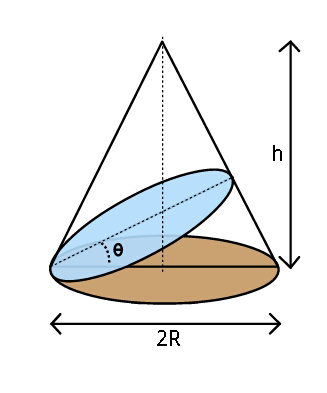
Commented by ajfour last updated on 20/Sep/18
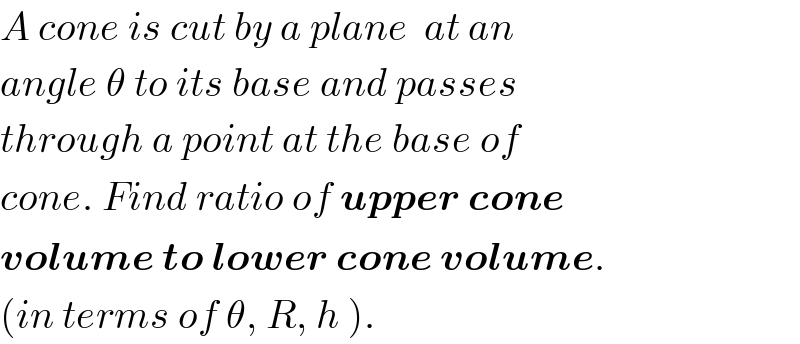
$${A}\:{cone}\:{is}\:{cut}\:{by}\:{a}\:{plane}\:\:{at}\:{an} \\ $$$${angle}\:\theta\:{to}\:{its}\:{base}\:{and}\:{passes} \\ $$$${through}\:{a}\:{point}\:{at}\:{the}\:{base}\:{of} \\ $$$${cone}.\:{Find}\:{ratio}\:{of}\:\boldsymbol{{upper}}\:\boldsymbol{{cone}} \\ $$$$\boldsymbol{{volume}}\:\boldsymbol{{to}}\:\boldsymbol{{lower}}\:\boldsymbol{{cone}}\:\boldsymbol{{volume}}. \\ $$$$\left({in}\:{terms}\:{of}\:\theta,\:{R},\:{h}\:\right). \\ $$
Commented by MrW3 last updated on 22/Sep/18

$${thank}\:{you}\:{sir}!\: \\ $$
Commented by ajfour last updated on 22/Sep/18
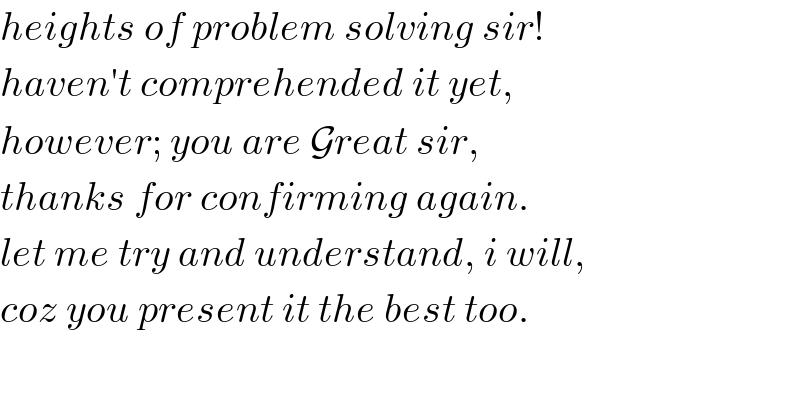
$${heights}\:{of}\:{problem}\:{solving}\:{sir}! \\ $$$${haven}'{t}\:{comprehended}\:{it}\:{yet}, \\ $$$${however};\:{you}\:{are}\:\mathcal{G}{reat}\:{sir}, \\ $$$${thanks}\:{for}\:{confirming}\:{again}. \\ $$$${let}\:{me}\:{try}\:{and}\:{understand},\:{i}\:{will}, \\ $$$${coz}\:{you}\:{present}\:{it}\:{the}\:{best}\:{too}. \\ $$$$ \\ $$
Answered by MrW3 last updated on 24/Sep/18
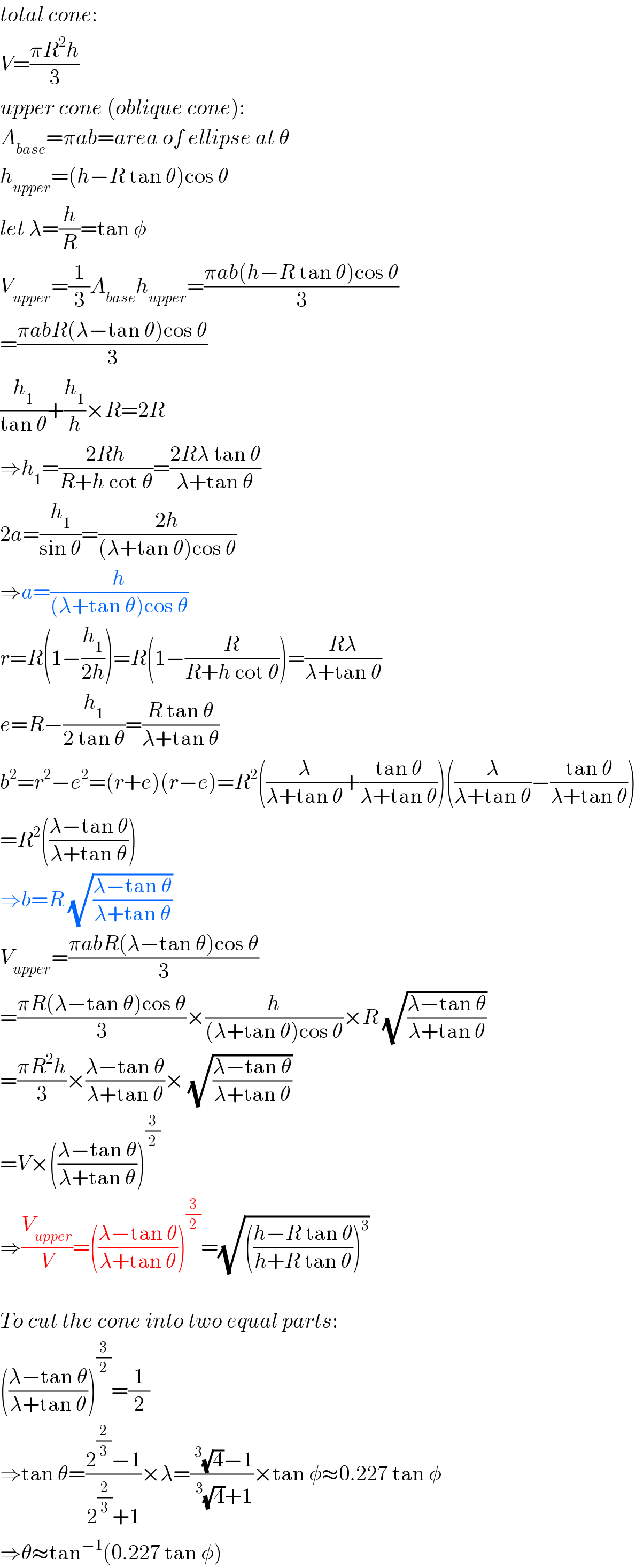
$${total}\:{cone}: \\ $$$${V}=\frac{\pi{R}^{\mathrm{2}} {h}}{\mathrm{3}} \\ $$$${upper}\:{cone}\:\left({oblique}\:{cone}\right): \\ $$$${A}_{{base}} =\pi{ab}={area}\:{of}\:{ellipse}\:{at}\:\theta \\ $$$${h}_{{upper}} =\left({h}−{R}\:\mathrm{tan}\:\theta\right)\mathrm{cos}\:\theta \\ $$$${let}\:\lambda=\frac{{h}}{{R}}=\mathrm{tan}\:\phi \\ $$$${V}_{{upper}} =\frac{\mathrm{1}}{\mathrm{3}}{A}_{{base}} {h}_{{upper}} =\frac{\pi{ab}\left({h}−{R}\:\mathrm{tan}\:\theta\right)\mathrm{cos}\:\theta}{\mathrm{3}} \\ $$$$=\frac{\pi{abR}\left(\lambda−\mathrm{tan}\:\theta\right)\mathrm{cos}\:\theta}{\mathrm{3}} \\ $$$$\frac{{h}_{\mathrm{1}} }{\mathrm{tan}\:\theta}+\frac{{h}_{\mathrm{1}} }{{h}}×{R}=\mathrm{2}{R} \\ $$$$\Rightarrow{h}_{\mathrm{1}} =\frac{\mathrm{2}{Rh}}{{R}+{h}\:\mathrm{cot}\:\theta}=\frac{\mathrm{2}{R}\lambda\:\mathrm{tan}\:\theta}{\lambda+\mathrm{tan}\:\theta} \\ $$$$\mathrm{2}{a}=\frac{{h}_{\mathrm{1}} }{\mathrm{sin}\:\theta}=\frac{\mathrm{2}{h}}{\left(\lambda+\mathrm{tan}\:\theta\right)\mathrm{cos}\:\theta} \\ $$$$\Rightarrow{a}=\frac{{h}}{\left(\lambda+\mathrm{tan}\:\theta\right)\mathrm{cos}\:\theta} \\ $$$${r}={R}\left(\mathrm{1}−\frac{{h}_{\mathrm{1}} }{\mathrm{2}{h}}\right)={R}\left(\mathrm{1}−\frac{{R}}{{R}+{h}\:\mathrm{cot}\:\theta}\right)=\frac{{R}\lambda}{\lambda+\mathrm{tan}\:\theta} \\ $$$${e}={R}−\frac{{h}_{\mathrm{1}} }{\mathrm{2}\:\mathrm{tan}\:\theta}=\frac{{R}\:\mathrm{tan}\:\theta}{\lambda+\mathrm{tan}\:\theta} \\ $$$${b}^{\mathrm{2}} ={r}^{\mathrm{2}} −{e}^{\mathrm{2}} =\left({r}+{e}\right)\left({r}−{e}\right)={R}^{\mathrm{2}} \left(\frac{\lambda}{\lambda+\mathrm{tan}\:\theta}+\frac{\mathrm{tan}\:\theta}{\lambda+\mathrm{tan}\:\theta}\right)\left(\frac{\lambda}{\lambda+\mathrm{tan}\:\theta}−\frac{\mathrm{tan}\:\theta}{\lambda+\mathrm{tan}\:\theta}\right) \\ $$$$={R}^{\mathrm{2}} \left(\frac{\lambda−\mathrm{tan}\:\theta}{\lambda+\mathrm{tan}\:\theta}\right) \\ $$$$\Rightarrow{b}={R}\:\sqrt{\frac{\lambda−\mathrm{tan}\:\theta}{\lambda+\mathrm{tan}\:\theta}} \\ $$$${V}_{{upper}} =\frac{\pi{abR}\left(\lambda−\mathrm{tan}\:\theta\right)\mathrm{cos}\:\theta}{\mathrm{3}} \\ $$$$=\frac{\pi{R}\left(\lambda−\mathrm{tan}\:\theta\right)\mathrm{cos}\:\theta}{\mathrm{3}}×\frac{{h}}{\left(\lambda+\mathrm{tan}\:\theta\right)\mathrm{cos}\:\theta}×{R}\:\sqrt{\frac{\lambda−\mathrm{tan}\:\theta}{\lambda+\mathrm{tan}\:\theta}} \\ $$$$=\frac{\pi{R}^{\mathrm{2}} {h}}{\mathrm{3}}×\frac{\lambda−\mathrm{tan}\:\theta}{\lambda+\mathrm{tan}\:\theta}×\:\sqrt{\frac{\lambda−\mathrm{tan}\:\theta}{\lambda+\mathrm{tan}\:\theta}} \\ $$$$={V}×\left(\frac{\lambda−\mathrm{tan}\:\theta}{\lambda+\mathrm{tan}\:\theta}\right)^{\frac{\mathrm{3}}{\mathrm{2}}} \\ $$$$\Rightarrow\frac{{V}_{{upper}} }{{V}}=\left(\frac{\lambda−\mathrm{tan}\:\theta}{\lambda+\mathrm{tan}\:\theta}\right)^{\frac{\mathrm{3}}{\mathrm{2}}} =\sqrt{\left(\frac{{h}−{R}\:\mathrm{tan}\:\theta}{{h}+{R}\:\mathrm{tan}\:\theta}\right)^{\mathrm{3}} } \\ $$$$ \\ $$$${To}\:{cut}\:{the}\:{cone}\:{into}\:{two}\:{equal}\:{parts}: \\ $$$$\left(\frac{\lambda−\mathrm{tan}\:\theta}{\lambda+\mathrm{tan}\:\theta}\right)^{\frac{\mathrm{3}}{\mathrm{2}}} =\frac{\mathrm{1}}{\mathrm{2}} \\ $$$$\Rightarrow\mathrm{tan}\:\theta=\frac{\mathrm{2}^{\frac{\mathrm{2}}{\mathrm{3}}} −\mathrm{1}}{\mathrm{2}^{\frac{\mathrm{2}}{\mathrm{3}}} +\mathrm{1}}×\lambda=\frac{\:^{\mathrm{3}} \sqrt{\mathrm{4}}−\mathrm{1}}{\:^{\mathrm{3}} \sqrt{\mathrm{4}}+\mathrm{1}}×\mathrm{tan}\:\phi\approx\mathrm{0}.\mathrm{227}\:\mathrm{tan}\:\phi \\ $$$$\Rightarrow\theta\approx\mathrm{tan}^{−\mathrm{1}} \left(\mathrm{0}.\mathrm{227}\:\mathrm{tan}\:\phi\right) \\ $$
Commented by MrW3 last updated on 22/Sep/18
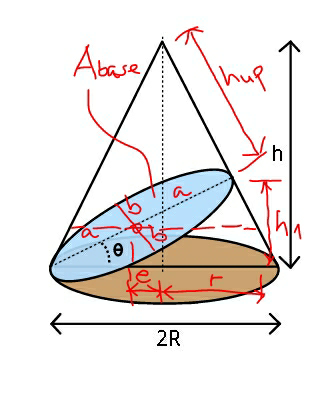
Commented by MrW3 last updated on 22/Sep/18
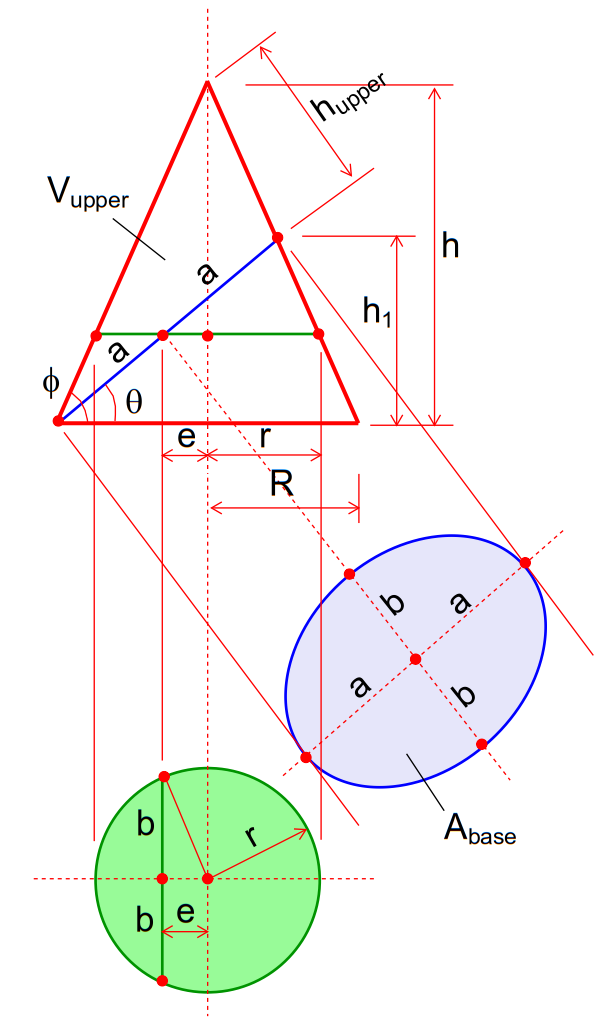
Commented by ajfour last updated on 17/Nov/18

$${thank}\:{you}\:{sir},\:{hats}\:{off}\:!\: \\ $$
Commented by MrW3 last updated on 23/Sep/18
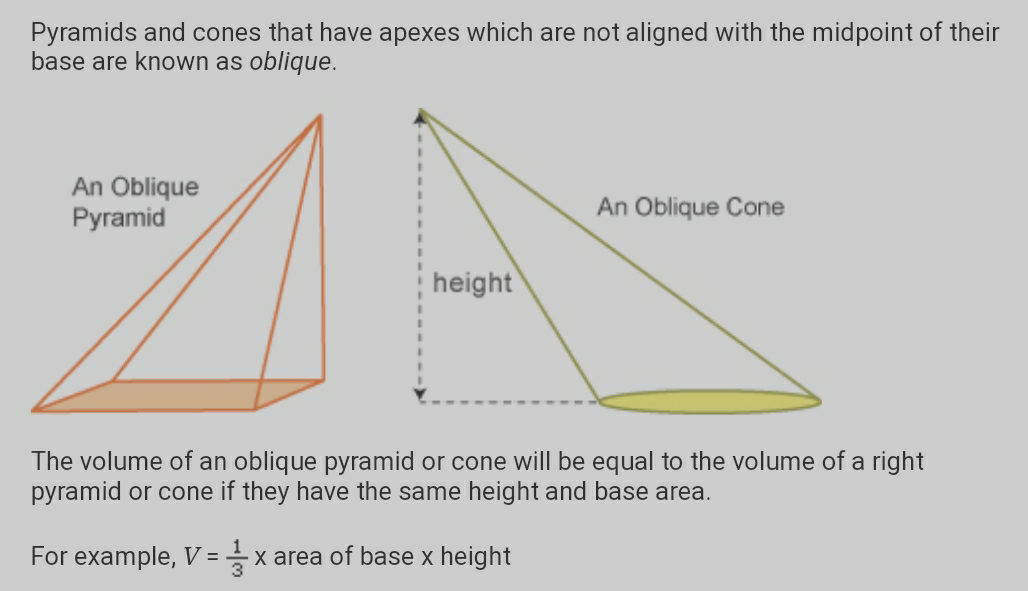
Commented by ajfour last updated on 17/Nov/18

$${Sir},{i}\:{have}\:{difficulty}\:{in}\:{under}- \\ $$$${standing}\:\:{b}^{\mathrm{2}} +{e}^{\mathrm{2}} =\:{r}^{\mathrm{2}} \:;\:{but}\:{you} \\ $$$${have}\:{already}\:{explained},{let}\:{me} \\ $$$${try}\:{again},\:{thanks}. \\ $$
